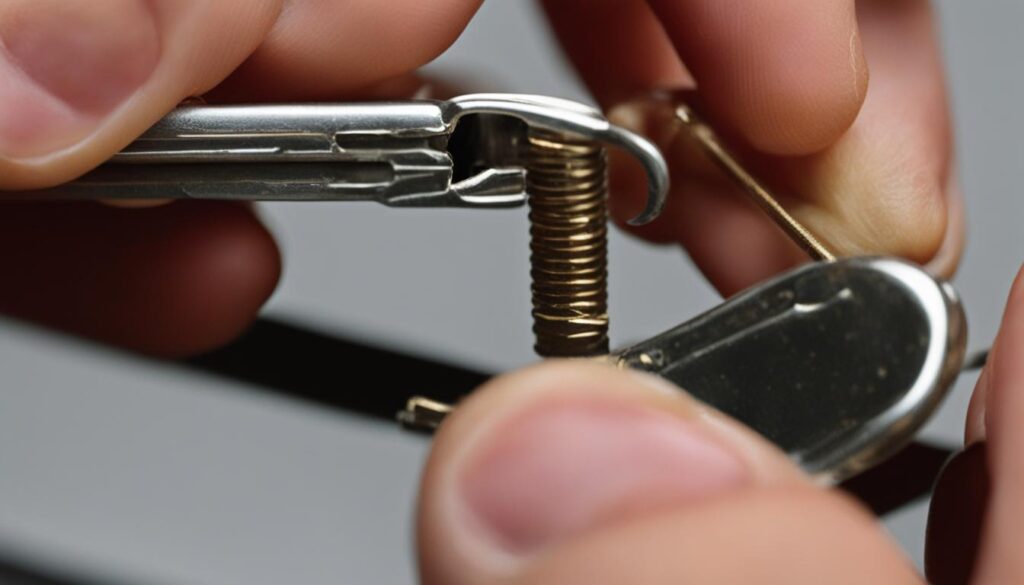Picking locks with a safety pin is a skill that can come in handy, especially if you find yourself frequently misplacing your keys. In this tutorial, I will guide you through the step-by-step process of lock picking with a safety pin, providing you with the knowledge and techniques needed to successfully open locks.
Whether you’re a beginner or have some experience with lock picking, this how to pick a lock with safety pin tutorial will equip you with the essential tips and techniques to improve your abilities. So, let’s dive in and learn how to pick a lock with a safety pin!
How to Pick a Lock with Safety Pin in 3 steps
Lock picking with a safety pin may seem like a daunting task, but with the right techniques and practice, it can become an achievable skill. Here are some essential tips to help beginners get started on their lock picking journey:
1. Gather the right tools
Before attempting to pick a lock with a safety pin, make sure you have the necessary tools. Apart from a safety pin, you’ll also need a tension wrench, which applies pressure to the lock’s pins, and a small flashlight to help you see inside the lock.
2. Understand the lock mechanism
Each lock has a unique mechanism, and familiarizing yourself with how it works is crucial for successful lock picking. Take some time to study the different types of locks and their inner workings. This knowledge will help you apply the right techniques when using a safety pin to pick a lock.
3. Start with practice locks
Beginners should start practicing on locks specifically designed for learning purposes. These practice locks have visible pins and provide a better understanding of how the lock picking process works. As you gain confidence and skill, you can move on to more complex locks.
Remember, lock picking should be approached ethically and responsibly. Use this knowledge for personal use and with proper authorization. Now that you have the essential tips in mind, you’re ready to begin your lock picking journey with a safety pin!
Exploring Lock Picking Techniques Using a Safety Pin
When it comes to DIY lock picking, a safety pin can be a surprisingly effective tool. With a little practice and the right techniques, you can improve your lock picking skills and gain a greater understanding of how locks work. In this section, we will explore various lock picking techniques using a safety pin.
Single Pin Picking
One common technique is single pin picking, which involves manipulating each individual pin within the lock cylinder. To begin, insert the bent end of the safety pin into the keyway and use it as a tension wrench. Apply slight tension and then use another straightened safety pin as a pick to carefully lift each pin, one at a time, until all pins align with the shear line, allowing the lock to rotate.
Raking
Raking is another technique that involves quickly moving a pick back and forth across the pins to simulate the action of a key. With a safety pin, you can create a makeshift rake by bending the straight end at different angles. Insert the tension wrench into the keyway, apply tension, and then rake the pins with the bent safety pin. This technique is helpful for quickly opening simple locks.
Impressioning
Impressioning is a technique that involves making an impression of the lock pins on a blank key. This can be done with a safety pin by filing down the tip to create a flat surface. Insert the pin into the lock and lightly turn it back and forth while applying slight pressure. The pins will leave marks on the pin surface, indicating their positions. Repeat this process several times, gradually filing away the marked areas until the pin surface matches the correct key pattern.
These are just a few examples of the lock picking techniques you can explore using a safety pin. Remember, lock picking should only be done for educational purposes or with proper authorization. Practice on your own locks or seek professional guidance to ensure you use these skills responsibly and ethically.

Ensuring Successful Lock Picking with a Safety Pin
Mastering the art of lock picking with a safety pin requires practice, patience, and a deep understanding of the process. By following a few key tips, you can increase your chances of successfully picking locks with a safety pin.
Tip #1: Choose the Right Safety Pin
Not all safety pins are created equal when it comes to lock picking. Look for a safety pin with a thin, flexible shaft and a sharp, pointed tip. This will allow for easier maneuvering inside the lock mechanism and increase your chances of success.
Tip #2: Focus on Tension
Applying the right amount of tension is crucial in lock picking. Use your thumb or a tension wrench to apply a steady, gentle pressure in the direction opposite to the lock’s rotation. Experiment with different amounts of tension to find the sweet spot that allows the pins to move freely.
Tip #3: Use Light Pressure and Feel for the Pins
When inserting the safety pin into the lock, apply light pressure and move it in a gentle, raking or scrubbing motion. As you do this, pay close attention to the sensation under your finger. You should feel the pins interacting with the tip of the safety pin. Once you feel the pins set, apply a little more pressure to turn the lock.
Remember, lock picking should only be done ethically and with the necessary permissions. Practice on your own locks or seek professional training to develop your skills responsibly.
Understanding Locks and Pins for Successful Picking
When it comes to successfully picking a lock using a safety pin, it’s crucial to have a good understanding of how locks and pins work. This knowledge will greatly enhance your lock-picking techniques and increase your chances of success.
Locks typically consist of a series of pins that are held in place by a key. When the correct key is inserted into the lock, the pins align and allow the lock to turn. However, when you don’t have the key, you need to manipulate the pins manually to mimic the effect of a key. This is where a safety pin comes in handy.
When using a safety pin to pick a lock, it’s important to know that each pin has different lengths. These pins are set in a way that creates a shear line within the lock. By applying tension with a tension wrench and carefully manipulating the pins using the safety pin, you can gradually move each pin into the correct position, allowing the lock to turn.
Key Points to Remember:
1. Apply consistent and gentle tension to the lock using a tension wrench to create a small gap between the pins.
2. Use the safety pin as a makeshift pick to carefully lift each pin, one by one, until they align with the shear line.
3. Pay close attention to the feedback you feel through the tension wrench. Small vibrations or clicks indicate that a pin has reached the correct position.
4. Be patient and take your time when picking a lock. It may require multiple attempts before you successfully open it.
By understanding the mechanics of locks and pins, you’ll be better equipped to develop and refine your lock picking techniques using a safety pin. Remember that lock picking should only be done legally and responsibly, and always seek permission before attempting to pick someone else’s locks.
Conclusion
Learning how to pick a lock with a safety pin can be a valuable skill to have, providing you with the ability to access locked items when needed. However, it’s important to remember that lock picking should only be used responsibly and ethically.
When practicing lock picking, always start with cheap locks that you own or have permission to pick. This way, you can avoid any potential legal or ethical issues. Remember, lock picking without proper authorization is illegal and can have serious consequences.
To improve your lock picking abilities, it’s crucial to stay patient and focused. Lock picking requires precision and practice. The more you practice, the better you’ll become at understanding the mechanics of locks and pins, allowing you to pick them more effectively.
Keep in mind that lock picking is a skill that should only be used in specific situations where you have legitimate access rights. It’s not meant to be used for illegal activities or to invade someone’s privacy. Always respect the law and the privacy of others.
FAQ
Is it legal to pick locks with a safety pin?
Lock picking with a safety pin is a valuable skill to have, but it’s important to use this knowledge responsibly and ethically. Always seek permission before attempting to pick someone else’s locks and only practice on locks that you own or have permission to practice on.
Can I use any type of safety pin for lock picking?
While it’s possible to pick a lock with various types of safety pins, it’s best to use a large, sturdy safety pin with a straight body. This will provide better control and increase your chances of success.
Do I need special tools to pick a lock with a safety pin?
Aside from a safety pin, you may also need a tension wrench or a flathead screwdriver to apply tension to the lock while picking the pins. These tools can easily be found at most hardware stores or online.
How long does it take to learn how to pick a lock with a safety pin?
The time it takes to learn how to pick a lock with a safety pin can vary depending on the individual. It’s a skill that requires practice, patience, and a good understanding of the mechanics of locks and pins. With consistent practice, you can improve your lock picking abilities over time.
Can picking a lock with a safety pin damage the lock?
There is a risk of damaging the lock or breaking the safety pin if proper technique is not used. It’s important to apply gentle pressure and not force the pins. If you encounter resistance or difficulty, it’s best to stop and reassess your technique to avoid any potential damage.
What should I do if I accidentally lock myself out of my own house?
If you find yourself locked out of your own house, it’s recommended to contact a professional locksmith who can help you gain access without causing any damage to your lock or door. Attempting to pick the lock yourself may not only damage the lock but also void any warranty or insurance coverage you may have.

